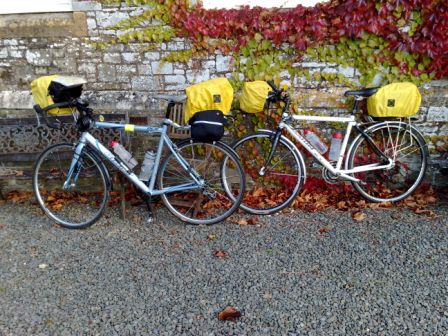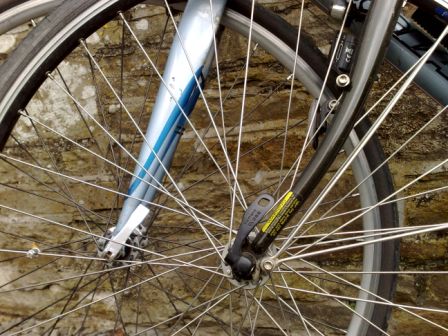

Cycle LEJOG
Cycle West France
Cycle North Spain
Cycle Devon
Touring tips and hints
Bikes
Bikes come in many shapes and sizes. All are designed for a slightly different purpose. For touring, a strong, durable, comfortable bike that can be easily repaired is usually the main requirement. Bikes fall into one of the following 4 categories:
Road bikes
Stiff frame that is difficult to repair, narrow wheel rims and tyres, aerodynamic riding position, lightweight components, narrow range of gears, no mudguards or rack. If your goal is to complete Lands End to John O'Groats (LEJOG) as fast as possible, possibly with a backup team, this is the bike for you. If not, then by the time you have added mudguards, a rack, changed the gear ratios and added wider tyres, you may as well start with a more comfortable reliable bike. Roger used a road bike for touring for many years and had no problems except on cycle paths.
Hybrid bikes
A comfortable frame, straight handlebars, usually with a rack. Hybrids can make for a good touring bike although some will find the fixed riding position too limited, the gears too narrow and the rims not able to take wider tyres. Helen used a hybrid bike for many years for touring, and had few problems apart from shoulder ache (from the fixed riding position).
Mountain Bikes
Wide knobbly tyres, wide gears, suspension, no mudguards or rack. Great for off road trails, usually too ‘draggy’ for roads. If you do intend to use a mountain bike for touring, change the tyres to smoother road tyres, and ensure the suspension can be fixed for road use.
Touring bikes
As the name suggests, these are designed for long distance touring. A typical touring bike with have a steel frame (steel absorbs the shocks better and can be easily repaired), wide gear ratio, wide rims and tyres and a relaxed riding position with a choice of hand positions and a rack. Brakes, gears, wheels etc will be designed for strength, not minimum weight.
If you are loaded up with water, luggage and perhaps a tent, a strong, comfortable touring bike with wide ratio gears is preferable to a lightweight greyhound of a road bike. Our preferred bikes are touring bikes with wide gears and 32-38mm tyres although we have toured on road and hybrid bikes. Helen uses a Dawes Kara-Kum and Roger a Claude Butler Dalesman.

Touring forks (black) are curved to absorb shocks. Road forks are straight
Saddles
The main point of connection between person and bike is well worth getting right. Women will find the additional comfort from a woman’s saddle well worth the effort and cost. We have a garage full of spares as Helen worked her way through the local bike shop finding one right for her. She settled on the Specialized windieXC.
Roger’s favourite touring saddle is a heavy, leather, Brooks champion B17. Once broken in (about 600 miles), this has to be the world’s most comfortable saddle – amazing for something designed at the turn of the last century.
Tyres
The humble tyre makes a huge difference to the comfort of a long ride. Narrow, slick racing tyres are great for fast travel on smooth roads, but are generally unsuitable for touring where the odd bit of bumpy cycle path is encountered. We use a tyre width of 32-38mm. As we always carry a pump, we will often reduce the tyre pressure if riding for long periods on bumpy cycle paths, but pump back to normal pressure for roads. Current prefered tyre is the Schwalbe supreme, although perhaps a little smooth for off road use.
Bags and luggage
Firstly, don’t even think about carrying your luggage on your back. Invest in proper bike luggage. One of our best investments was a good bar bag. We use the ones made by Altura which double up as the map case. As well as items needed to hand during the ride, we also put any valuables into these, as the bag is quick and easy to remove and carry.
For a couple of weeks B&B cycling, this bar bag plus a small rack bag is all we take, 5L for the bar bag and 10L for the rack bag. Rack bags tend to be lighter than panniers, and because they are in the slipstream, offer less wind resistance.
If touring for longer, or if camping, we use two rear panniers. Many people rate the Ortlieb roller panniers to be the best. Lidl offer a pannier similar to the Ortlieb ones, but at a fraction of the price.
The bigger the bags, the more one is tempted to take. It is amazing just how little is required if you can wash clothes every night and are prepared to not wear the latest fashion.
We always buy bags in a visible colour, or cover the bags with a highly visible cover that also acts as a rain cover.
Clothes and visibility
Cyclists wearing bright lycra is a cliché. However, proper cycling clothes do make touring much more comfortable, although sometimes you can feel rather stupid when walking through towns. High wicking tops help to evaporate the sweat, man made fibres retain some degree of heat insulation when wet and proper cycling trousers not only add extra padding but do not rub when wet. Cycle clothes dry quickly after washing. Bright colours help to make you more visible, although we often rely on bright bag covers.
Some countries now require the wearing of high visibility clothing outside towns when cycling in the dark or in poor visibility.
We use cycle shoes with SPD clips (mountain bike type with recessed clips), although it does mean we have to carry an additional pair of non-clipped shoes for general walking.
Tools and spares
A small collection of basic repair tools makes the trip a little more secure, although it is impossible to cover all eventualities. We carry our tools and spares in a half size drink bottle, attached to a 3rd bottle carrier on the frame. Our kit includes:
Spare inner tube, sized to fit tyres on all our bikes (28-38 in our case)
Tube repair kit and tyre levers
Multitool kit including allen keys, chain link tool, spoke spanner, screwdrivers
Spare chain link (connex type)
Tyrap (cable ties)
If on a long trip away from repair shops, we will carry spare spokes, brake pads and brake and gear cable.
Training
Building stamina takes time and effort but once gained can be kept with far less effort. For our first long distance ride, we built up slowly over six months, starting with about 30 mile rides and building to 90 mile rides, increasing 10 miles per month. Since then, just by doing the odd 20-30 mile cycle during the week, we can now jump on a bike and do 60 miles with luggage, with no additional training. In practice, what we were building was time in the saddle, rather than distance. The terrain, headwinds, and weight carried greatly change the average speed so saddle time becomes more important in training than distance.
Maps and planning
Pleasurable touring is all about finding those nice quiet roads to ride along. If the map scale is too coarse, the minor roads are not shown. A 3mile / inch is the highest scale we will use, but prefer 2 miles or less per inch. To save carrying heavy maps with us, we colour our intended route with a highlighter, then cut the maps into strips, only taking the strips we need. To save ruining the map, a colour photocopier can be used. The copied pages are much easier to fold into a map wallet than a large folded map or map book.
A small compass helps the turn left/right decisions on cloudy days.
The free GPS maps on our Nokia mobile phone come in very handy.
We know our comfortable saddle time from our training, so to plan our daily distance, we simply multiply our intended saddle time by our expected average speed. The expected average is based on our normal speed, taking into account the bikes, luggage, headwinds and terrain.
How hilly is hilly? This may seem like a silly question, but how do you relate the expected terrain to speed? Many computer route planning programs give a height profile. Our experience is that if the height gained is less than 25 feet per mile (25' up and 25' down, so 25' up over 0.5 miles or 1% average gradient) the effect on speed is minimal. The decrease in speed on the way up is compensated by the increase on the way down. For terrain > 100' climb per mile, this is very hilly, and the average speed will reduce to about 70% of normal. Greater than 100'/mile means grinding up hills and full brakes on the way down.
Cycle paths can be very slow, depending on the surface and frequency of barriers at road and other junctions.
Calorie burn
It always amazes us how many people claim to have burnt 1000 calories, just because their cycle computer says so. The same people believe their computer when it tells them that calorie burn goes up when on a faster, lighter bike or down when going up hill! Most cycle computers do not take into account head winds, type of bike, bike or rider’s weight or the terrain; only speed. A heart rate monitor is a better method but who wants to wear a sweaty chest belt all the time.
Our preferred method to calculate calorie burn is to use the riding time multiplied by an average burn rate per hour. Most people will exert the same effort regardless of a head wind, weight carried or terrain, they just go slower if on a heavy bike with a head wind. As an example, Roger weighs 14.5 st (203 lbs, 93 Kgms) and averages around 17MPH in zero wind on the flat riding an old heavy road bike. He reckons to burn 500 Kcal/hour when cycling moderately, 600 if cycling hard or 400 if being gentle. When touring, he cycles gently, so if we are 5 hours in the saddle, he will burn around 2000 Kcals. For a 3 hour leg burning training session, the calories consumed will be 1800 Kcals.
Looking after the engine
Water and carbohydrates are the two essentials for touring, especially water. At least 1.5 - 2L per person is required, often more when hot. During the first few days, the body appears to go through an adjustment period, when food high in carbohydrates is constantly required. After these first days, the time between food intake can be lengthened. Some people like to use the combined electrolyte & carbohydrate drinks, such as manufactured by SIS. The cyclist mantra for food - little and often - is good advice.
Finally, remember that cycle touring is like life - it's the journey that is fun, not the destination!
Final question:
Found this page useful? Why not raise some money for charity whilst cycle touring. Have a look here at a charity that is supporting the Maasai people in southern Kenya. They are currently trying to build a school as well as doing clean water projects. All money raised goes to Kenya as there are no UK salaries or expenses.
Back to Top
.